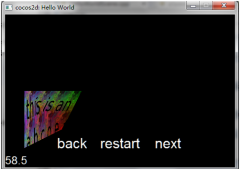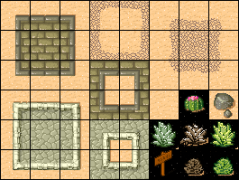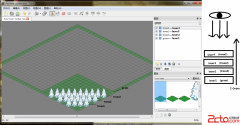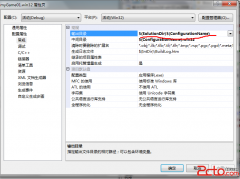cocos2d-x学习笔记-触屏事件详解
游戏跟视频最大的区别就是互动,玩家可以操控游戏中的角色,现在的移动设备几乎人手一台,基本上全部都是基于触屏操作的,今天就来学习一下cocos2d-x是怎么实现对触屏操作的处理的。
1.首先来了解一下相关的几个类、处理触屏事件时操作和执行的流程
CCTouch:它封装了触摸点,可以通过locationInView函数返回一个CCPoint。
CCTouchDelegate:它是触摸事件委托,就是系统捕捉到触摸事件后交由它或者它的子类处理,所以我们在处理触屏事件时,必须得继承它。它封装了下面这些处理触屏事件的函数:
[cpp]
virtual void ccTouchesBegan(CCSet *pTouches, CCEvent *pEvent);
virtual void ccTouchesMoved(CCSet *pTouches, CCEvent *pEvent);
virtual void ccTouchesEnded(CCSet *pTouches, CCEvent *pEvent);
virtual void ccTouchesCancelled(CCSet *pTouches, CCEvent *pEvent);
virtual bool ccTouchBegan(CCTouch *pTouch, CCEvent *pEvent);
virtual void ccTouchMoved(CCTouch *pTouch, CCEvent *pEvent);
virtual void ccTouchEnded(CCTouch *pTouch, CCEvent *pEvent);
virtual void ccTouchCancelled(CCTouch *pTouch, CCEvent *pEvent);
ccTouchesCancelled和ccTouchCancelled函数很少用,在接到系统中断通知,需要取消触摸事件的时候才会调用此方法。如:应用长时间无响应、当前view从window上移除、触摸的时候来电话了等。
CCTargetedTouchDelegate和CCStandardTouchDelegate是CCTouchDelegate的子类,类结构图如下:

CCStandardTouchDelegate用于处理多点触摸;CCTargetedTouchDelegate用于处理单点触摸。
CCTouchDispatcher:实现触摸事件分发,它封装了下面这两个函数,可以把CCStandardTouchDelegate和CCTargetedTouchDelegate添加到分发列表中:
[cpp] view plaincopy
void addStandardDelegate(CCTouchDelegate *pDelegate, int nPriority);
void addTargetedDelegate(CCTouchDelegate *pDelegate, int nPriority, bool bSwallowsTouches);
CCTouchHandler:封装了CCTouchDelegate和其对应的优先级,优先级越高,分发的时候越容易获得事件处理权,CCStandardTouchHandler和CCTargetedTouchHandler是它的子类。
下面分析一下触屏事件处理和执行流程:
用户自定义类继承CCTouchDelegate,重写触屏事件处理函数和registerWithTouchDispatcher函数,在init或者onEnter函数中调用registerWithTouchDispatcher函数,如:
[cpp]
void GameLayer::registerWithTouchDispatcher()
{
cocos2d::CCTouchDispatcher::sharedDispatcher()->addTargetedDelegate(this, 0, true);
}
把相应的CCTouchDelegate添加到CCTouchDispatcher的分发列表中。addTargetedDelegate函数会创建CCTouchDelegate对应的CCTouchHandler对象并添加到CCMutableArraym_pTargetedHandlers中,看源码:
[cpp
void CCTouchDispatcher::addTargetedDelegate(CCTouchDelegate *pDelegate, int nPriority, bool bSwallowsTouches)
{
CCTouchHandler *pHandler = CCTargetedTouchHandler::handlerWithDelegate(pDelegate, nPriority, bSwallowsTouches);
if (! m_bLocked)
{
forceAddHandler(pHandler, m_pTargetedHandlers);
}
else
{
/**....*/
}
}
void CCTouchDispatcher::forceAddHandler(CCTouchHandler *pHandler, CCMutableArray *pArray)
{
unsigned int u = 0;
CCMutableArray::CCMutableArrayIterator iter;
for (iter = pArray->begin(); iter != pArray->end(); ++iter)
{
CCTouchHandler *h = *iter;
if (h)
{
if (h->getPriority() < pHandler->getPriority())
{
++u;
}
if (h->getDelegate() == pHandler->getDelegate())
{
CCAssert(0, "");
return;
}
}
}
pArray->insertObjectAtIndex(pHandler, u);
}
事件分发时就是从m_pTargetedHandlers中取出CCXXXTouchHandler,然后调用delegate的:pHandler->getDelegate()->ccTouchBegan(pTouch, pEvent);,执行的是CCTouchDispatcher的touches函数,考虑到篇幅问题,就不贴出具体代码了。该函数首先会先处理targeted 再处理standard,所以CCTargetedTouchDelegate比CCStandardTouchDelegate优先级高。那什么时候触发执行touches函数呢?CCTouchDispatcher继承了EGLTouchDelegate类,EGLTouchDelegate类源码:
[cpp]
class CC_DLL EGLTouchDelegate
{
public:
virtual void touchesBegan(CCSet* touches, CCEvent* pEvent) = 0;
virtual void touchesMoved(CCSet* touches, CCEvent* pEvent) = 0;
virtual void touchesEnded(CCSet* touches, CCEvent* pEvent) = 0;
virtual void touchesCancelled(CCSet* touches, CCEvent* pEvent) = 0;
virtual ~EGLTouchDelegate() {}
};
CCTouchDispatcher中实现了这四个函数,正是在这四个函数中调用了touches函数:
[cpp]
void CCTouchDispatcher::touchesBegan(CCSet *touches, CCEvent *pEvent)
{
if (m_bDispatchEvents)
{
this->touches(touches, pEvent, CCTOUCHBEGAN);
}
}
/**其他三个方法类似 **/
这几个触屏处理函数是由具体平台底层调用的,在AppDelegate.cpp中有这段代码:
[cpp]
CCDirector *pDirector = CCDirector::sharedDirector();
pDirector->setOpenGLView(&CCEGLView::sharedOpenGLView());
继续跟进setOpenGLView函数,发现了这段代码:
[cpp]
CCTouchDispatcher *pTouchDispatcher = CCTouchDispatcher::sharedDispatcher();
m_pobOpenGLView->setTouchDelegate(pTouchDispatcher);
pTouchDispatcher->setDispatchEvents(true);
调用了具体平台下的CCEGLView类中的setTouchDelegate函数。由于我是在windows平台下,所以CCEGLView此时对应CCEGLView_win32.h文件的CCEGLView类,对应的setTouchDelegate函数为:
[cpp]
void setTouchDelegate(EGLTouchDelegate * pDelegate);
系统最终通过CCEGLView类的WindowProc函数处理鼠标在Windows窗口的DOWN、MOVE、UP事件,通过pDelegate分别调用touchesBegan、touchesMoved、touchesEnded函数。
[cpp]
LRESULT CCEGLView::WindowProc(UINT message, WPARAM wParam, LPARAM lParam)
{
switch (message)
{
case WM_LBUTTONDOWN:
if (m_pDelegate && m_pTouch && MK_LBUTTON == wParam)
{
POINT pt = {(short)LOWORD(lParam), (short)HIWORD(lParam)};
if (PtInRect(&m_rcViewPort, pt))
{
m_bCaptured = true;
SetCapture(m_hWnd);
m_pTouch->SetTouchInfo(0, (float)(pt.x - m_rcViewPort.left) / m_fScreenScaleFactor,
(float)(pt.y - m_rcViewPort.top) / m_fScreenScaleFactor);
m_pSet->addObject(m_pTouch);
m_pDelegate->touchesBegan(m_pSet, NULL);
}
}
break;
case WM_MOUSEMOVE:
if (MK_LBUTTON == wParam && m_bCaptured)
{
m_pTouch->SetTouchInfo(0, (float)((short)LOWORD(lParam)- m_rcViewPort.left) / m_fScreenScaleFactor,
(float)((short)HIWORD(lParam) - m_rcViewPort.top) / m_fScreenScaleFactor);
m_pDelegate->touchesMoved(m_pSet, NULL);
}
break;
case WM_LBUTTONUP:
if (m_bCaptured)
{
m_pTouch->SetTouchInfo(0, (float)((short)LOWORD(lParam)- m_rcViewPort.left) / m_fScreenScaleFactor,
(float)((short)HIWORD(lParam) - m_rcViewPort.top) / m_fScreenScaleFactor);
m_pDelegate->touchesEnded(m_pSet, NULL);
m_pSet->removeObject(m_pTouch);
ReleaseCapture();
m_bCaptured = false;
}
break;
/** .... */
}
}
ok,现在应该明白了触屏操作相关函数的执行过程了,在其他平台下应该类似。
2. 实现触屏事件处理
知道了原理之后,实现起来就很简单了:定义一个CCTouchDelegate(或者其子类CCTargetedTouchDelegate/CCStandardTouchDelegate),然后重写那几个处理函数(began、move、end),并把定义好的CCTouchDelegate添加到分发列表中,在onExit函数中实现从分发列表中删除。
在平常的开发中,一般有两种方式:(1)继承CCLayer,在层中处理触屏函数。(2)继承CCSprite和CCTouchDelegate(或者其子类)。
上面两种方式,从原理上来说是一样的。
1. 下面是采用继承CCLayer的方式处理触屏事件。
(1)CCStandardTouchDelegate
添加CCStandardTouchDelegate是非常简单的,只需要重写触屏处理函数和调用setIsTouchEnabled(true)。主要代码如下:
[cpp]
//init函数中
this->setIsTouchEnabled(true);
void GameLayer::ccTouchesBegan(CCSet* pTouches,CCEvent* pEvent)
{
CCSetIterator it = pTouches->begin();
CCTouch* touch = (CCTouch*)(*it);
CCpoint touchLocation = touch->locationInView( touch->view() );
touchLocation = CCDirector::sharedDirector()->convertToGL(m_tBeginPos);
/** .... **/
}
这里为什么没有把CCStandardTouchDelegate添加进分发列表和从分发列表删除的操作呢,因为setIsTouchEnabled函数已经帮我们做了,看源码:
[cpp]
void CCLayer::setIsTouchEnabled(bool enabled)
{
if (m_bIsTouchEnabled != enabled)
{
m_bIsTouchEnabled = enabled;
if (m_bIsRunning)
{
if (enabled)
{
this->registerWithTouchDispatcher();
}
else
{
// have problems?
CCTouchDispatcher::sharedDispatcher()->removeDelegate(this);
}
}
}
}
void CCLayer::registerWithTouchDispatcher()
{
/** .... **/
CCTouchDispatcher::sharedDispatcher()->addStandardDelegate(this,0);
}
void CCLayer::onExit()
{
if( m_bIsTouchEnabled )
{
CCTouchDispatcher::sharedDispatcher()->removeDelegate(this);
unregisterScriptTouchHandler();
}
CCNode::onExit();
}
(2) CCTargetedTouchDelegate
直接看cocos2d-x中的CCMenu(菜单)类,它是继承CCLayer的。部分源码如下:
[cpp]
class CC_DLL CCMenu : public CCLayer, public CCRGBAProtocol
{
/** .... */
virtual void registerWithTouchDispatcher();
/**
@brief For phone event handle functions
*/
virtual bool ccTouchBegan(CCTouch* touch, CCEvent* event);
virtual void ccTouchEnded(CCTouch* touch, CCEvent* event);
virtual void ccTouchCancelled(CCTouch *touch, CCEvent* event);
virtual void ccTouchMoved(CCTouch* touch, CCEvent* event);
/**
@since v0.99.5
override onExit
*/
virtual void onExit();
/** .... */
};
}
//Menu - Events,在CCLayer的onEnter中被调用
void CCMenu::registerWithTouchDispatcher()
{
CCTouchDispatcher::sharedDispatcher()->addTargetedDelegate(this, kCCMenuTouchPriority, true);
}
bool CCMenu::ccTouchBegan(CCTouch* touch, CCEvent* event)
{
/** .... */
}
void CCMenu::onExit()
{
/** .... */
CCLayer::onExit();
}
2.下面实现继承CCSprite的方式
定义一个Ball类继承CCSprite和CCTargetedTouchDelegate。源码如下:
[cpp]
class Ball : public CCSprite, public CCTargetedTouchDelegate
{
public:
Ball(void);
virtual ~Ball(void);
virtual void onEnter();
virtual void onExit();
virtual bool ccTouchBegan(CCTouch* touch, CCEvent* event);
virtual void ccTouchMoved(CCTouch* touch, CCEvent* event);
virtual void ccTouchEnded(CCTouch* touch, CCEvent* event);
/** .... */
};
void Ball::onEnter()
{
CCTouchDispatcher::sharedDispatcher()->addTargetedDelegate(this, 0, true);
CCSprite::onEnter();
}
void Ball::onExit()
{
CCTouchDispatcher::sharedDispatcher()->removeDelegate(this);
CCSprite::onExit();
}
bool Ball::ccTouchBegan(CCTouch* touch, CCEvent* event)
{
CCPoint touchPoint = touch->locationInView( touch->view() );
touchPoint = CCDirector::sharedDirector()->convertToGL( touchPoint );
/** .... */
return true;
}
注意:virtual bool ccTouchBegan(CCTouch *pTouch, CCEvent *pEvent)的返回值对触屏消息是有影响的。
如果返回false,表示不处理ccTouchMoved(),ccTouchEnded(),ccTouchCanceld()方法,而交由后面接收触屏消息的对象处理;如果返回true,表示会处理ccTouchMoved(),ccTouchEnded(),ccTouchCanceld()方法,并且消耗掉此触屏消息,后面需要接收触屏消息的对象就接收不到触屏消息了。
相关新闻>>
- 发表评论
-
- 最新评论 进入详细评论页>>

![cocos2d_x+lua[2]](/uploads/allimg/131030/110J64609-0-lp.jpg)








